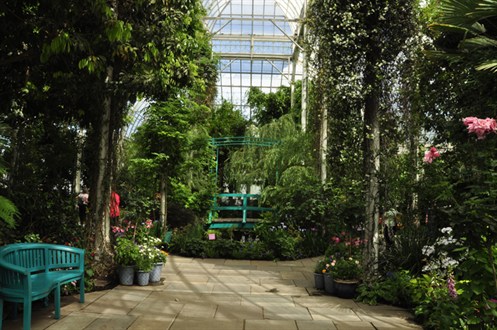Photog's log
11 o'clock on a fine Sunday morning
Such a fitting juxtaposition of gardens.
Both Monet's gardens in Giverny, France and the New York Botanical
Garden were originally created in the late Victorian era, each
on property across the road from a railway. Monet lived at Giverny
from 1883 until his death in 1926. He was eyeing the property
across the rails from his home and envisioning a pond when the NYBG
was established in 1891. While Monet was excavating the water lily
pond and building his famous bridge in 1893 and 1895, the NYBG was
hatching the grand plan for its Victorian style conservatory that
opened in 1902 and in 2012 featured gardens modeled on Monet's
Grand Allee.


Stroll through beauty, go home with ideas
The best thing about visiting public gardens is taking away
ideas for our own gardens.
Right: This painting reflected in the pond adds dimension
and color to the area. It could serve as a strategic vertical
screen in a pond in a small city garden, too. Hmmm... I could do
something like it in our pond with one of my photos printed on
cloth.
At the 1889 World Fair in Paris, Monet saw new water lilies, far
more colorful than what had been available. The new varieties (some
still were hybrids of European and North American species and
captured the whole spectrum in their petal colors. Like everyone
else who becomes wrapped up in a garden, he had to have them and
began ordering them as soon as he had his pond dug.
"All my money goes into my garden," he wrote.
Monet tried lotuses, too, but they failed to thrive in Giverny.
(Always fascinates me to consider European climate... such
as how Giverny can be on par with both northern Ontario and
northern Florida!)

(Click small images to see detail.)
A print of a Japanese garden inspired Monet's vision for his
pond and bridge. True to form he went his own way on color. No red
bridge for his pond! It's blue-green, as are the iron arches over
his Grand Allee.
Below: The NYBG recreation follows Monet's lead, echoing
bridge color in benches.

Color is my
day-long obsession,
joy and torment.
- Claude Monet -
My garden is my most beautiful
masterpiece. - Claude Monet -
 .
.
When Monet was painting works such as Water
Lilies...
...and could afford a 5-gardener staff to maintain his 4+ acres
of cottage garden and pond, the plantings at Giverny changed
throughout the year. Literally. Some plants remained in place but
many others were moved in and out to keep the color flowing. From
blue, violet and pale yellows in spring (irises, pansies, bulbs,
etc.) it morphed to rich pinks, blues and burgundy (peonies,
delphiniums, bellflowers, roses) and on into hot hues by late
summer (red dahlias, yellow sunflowers and orange
nasturtiums).
Above, left: Cool and pastel foxglove, delphiniums,
snapdragons, dianthus and larkspur have their turn, but the
gardeners won't be doing as much deadheading as clever
replacing, so summer can end in a wholly different color
scheme.
Above, right: Then, Zinnia and
flowering tobacco start to turn up the heat.
Even understanding the process intellectually, it strikes me at
gut level. I look at these densely packed beds, which capture just
a portion of Monet's 100-yard Grand Allee and think, "What a lot of
work, and what a dance to swap in and out in such tightly planted
spaces."
The NYBG staff is obviously up for this challenge. These irises,
foxgloves and delphiniums must have been swapped in since the
exhibit opened, and will soon be changed out for dahlias,
nasturtiums and zinnias. By October when this display ends in
sunflowers, asters and goldenrods, they'll have kept pace with
Monet's best, "painting" with about 600 varieties.
The quality of light, color... and water
I look down into the water from the bridge and wonder,
"Did Monet battle pond-choking algae?" He must have! Come to think
of it, the gardeners in Imperial Japanese gardens probably did,
too, since 'way back. How did they do it? Did they, like we, seek
out other pond tenders to talk natural balance in terms of fish
density and what portion of the water to cover with floating- and
aerifying plants? Did they swap secrets about submerged bales of
barley or adding powdered stone of certain (chemical) type?

Take-home assignment
I haven't yet ferreted his water quality tricks, but I've
learned that Monet did confront and eventually woo local
authorities to keep his pond, after failing to get proper permits
before changing the stream's flow to create his vision. (Am I
surprised that such regulations existed? No. The U.S. congress
enacted the Rivers and Harbors Act in 1890, with permit
requirements for obstruction or alteration of navigable
waterways.)

I also found that Monet charged his gardeners with rowing out to
clean railroad soot off the water lilies each morning. And, since
he's all about light and reflection (he said, "Take clear water
with grass waving at the bottom. It's wonderful to look at, but to
try to paint it is enough to make one insane.") So I'm going to bet
he objected to water-dulling algae, fought it with whatever means
were at hand and so we have that in common.
"You there, dragonfly. Will you sweep that bit of soot off
the petals while you're there? That's a good fellow."
Thorny issue of all those roses

Lots of old roses are climbing on the arches here. Roses
featured everywhere in Giverny. As one who is currently nursing the
wounds of rose deadheading and cutback season,
and who has a great respect for the nastiness of some shrub rose
thorns, I feel for Monet's gardeners and the NYBG staff. Youch.
Maybe they've already tucked aloe into strategic places...